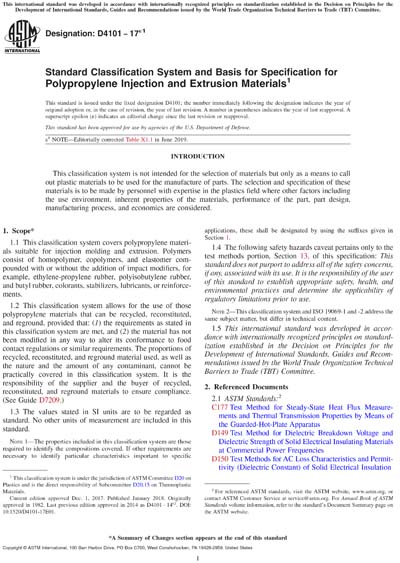Historical
ASTM D4101-17e1
Standard Classification System and Basis for Specification for Polypropylene Injection and Extrusion Materials
1.1 This classification system covers polypropylene materials suitable for injection molding and extrusion. Polymers consist of homopolymer, copolymers, and elastomer compounded with or without the addition of impact modifiers, for example, ethylene-propylene rubber, polyisobutylene rubber, and butyl rubber, colorants, stabilizers, lubricants, or reinforcements.
1.2 This classification system allows for the use of those polypropylene materials that can be recycled, reconstituted, and reground, provided that: (1) the requirements as stated in this classification system are met, and (2) the material has not been modified in any way to alter its conformance to food contact regulations or similar requirements. The proportions of recycled, reconstituted, and reground material used, as well as the nature and the amount of any contaminant, cannot be practically covered in this classification system. It is the responsibility of the supplier and the buyer of recycled, reconstituted, and reground materials to ensure compliance. (See Guide D7209.)
1.3 The values stated in SI units are to be regarded as standard. No other units of measurement are included in this standard.
Note 1: The properties included in this classification system are those required to identify the compositions covered. If other requirements are necessary to identify particular characteristics important to specific applications, these shall be designated by using the suffixes given in Section 1.
1.4 The following safety hazards caveat pertains only to the test methods portion, Section 13, of this specification: This standard does not purport to address all of the safety concerns, if any, associated with its use. It is the responsibility of the user of this standard to establish appropriate safety, health, and environmental practices and determine the applicability of regulatory limitations prior to use.
Note 2: This classification system and ISO 19069-1 and -2 address the same subject matter, but differ in technical content.
1.5 This international standard was developed in accordance with internationally recognized principles on standardization established in the Decision on Principles for the Development of International Standards, Guides and Recommendations issued by the World Trade Organization Technical Barriers to Trade (TBT) Committee.
ASTM International [astm]

